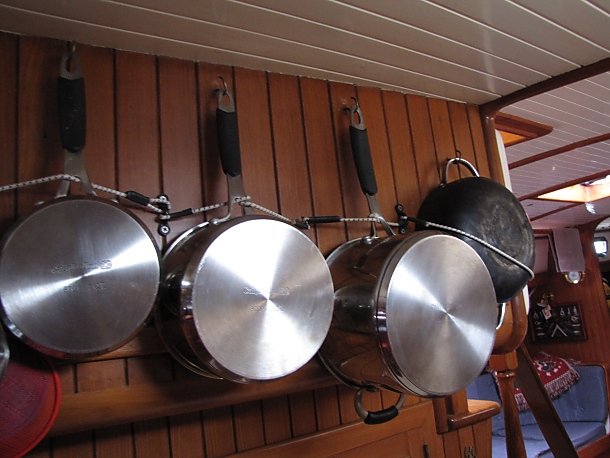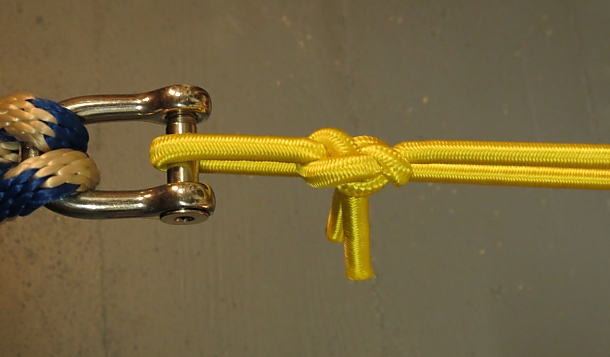The Blue View - The Ubiquitous Bungee Cord
/I must have a hundred uses for bungee cords aboard Nine of Cups, but my appreciation for them was slow to evolve. When we first moved aboard, I bought a bag of various sized bungee cords, each pre-constructed with hooks on the ends. Quite frankly, I didn't use them very much. It always seemed they were too long or too short for the particular application I had in mind, and if they were left unhooked for even a short period of time, they soon disappeared overboard.
I discovered that you could buy locking hooks that could be attached to the ends of any length bungee cord. The locking hooks stayed in place when the bungee wasn't under tension, so the bungee cord didn't get swept overboard, and it could be made to any length I needed. The downside was that the hooks are somewhat expensive and are a bear to assemble.
Then one day I realized that while many knots will not stay secure, there are several knots that do work well with bungee cord. I use two in particular: the common bowline works well to form a loop in the end of a bungee cord, and the Ashley Bend (see directions for tying this knot here) does a fine job of tying the two ends of a bungee cord together. If I want a hook on the end, I can attach a carabiner with a bowline. If, once it is tied, I pull the knot as tight as I can, it stays in place quite well. Quite the revelation, and it only took me about 4 years to discover it. (More evidence that anyone with even the meanest of intelligence can do this.)
I now carry two spools of bungee cord aboard, one 1/4” diameter and one 3/8” diameter. These two sizes handle most any application. When I need a bungee cord, I cut the necessary length from the spool, burn the ends with a lighter, and tie whatever knot is called for. It couldn't be simpler.
I use bungee cords for a myriad of applications. Here are some of them:
- Securing floorboards. The floorboards aboard the typical boat are removable to gain access to the bilge. We use this area to store spare parts, canned goods and heavy tools. If the boat were to be knocked down or, heaven forbid, rolled or pitch-poled, the floorboards as well as anything stored underneath could inflict some serious damage to the boat and crew. Thus, it is important to secure them in place. Bungee cords work well for this application (see a previous post on the subject of securing floorboards).
- Securing our pots and pans. We hang several pots and pans from hooks in the galley. When we are in a quiet port, they stay nicely in their places. When we are underway, however, the motion of the boat soon has them swinging and banging against the bulkhead and each other. I attached an eye pad on one side of each pan and a cup hook on the other. Using short lengths of bungee with a bowline tied in the ends, each pan is securely and quickly contained, yet easily accessed when needed.
- Securing halyards. We really dislike the sound of our halyards slapping against the mast and spreaders, especially down below. While is is not at all unpleasant to hear halyards clanging against a mast on someone else's boat as we walk through a marina, it is annoying onboard Cups. The sound seems to get magnified below deck, especially in the evening when we are trying to get to sleep. To prevent the clanging, we use bungee cords. For some of the halyards, we use a bungee cord permanently attached to a shroud with a bowline that has a carabiner attached to the halyard end. In other cases, we have a loop made up using an Ashley bend. The loop is attached to the mast pulpit, and the main halyard shackle clips to the loop and is tensioned.
- Fishing line shock-cord. When we fish, we usually troll with a lure attached to a steel leader, which is attached to 200 feet of 1/4” polyester line with a strength of 500 pounds. The line is wrapped around a winch in the reverse direction, then secured to a cleat with a few feet of slack in between. When a fish hits the lure, the line spins the winch, alerting us to the fact we have a fish. When the slack is taken up, the winch stops spinning and the line goes taut. We soon found that we needed to add some shock cord to the system or the sudden tension on the line would often either break the hook or jerk it out of the fish's mouth. I now tie two eyes in the line about 10 feet apart, between the winch and the stern rail and attach a length of bungee between the two eyes. The elasticity of the bungee prevents the sudden jerk and we catch far more fish.
- Lee cloths. Lee cloths are rectangular pieces of heavy cloth that keep us from falling out of our berths when the boat is heeled or rolling. On Cups, one side is attached to the berth and the other side is attached to cleats in the ceiling. Once we are in the berth with the lee cloths attached and tight, it is quite snug and comfy. The problem we had was figuring out a quick way to attach and detach the lee cloth from the ceiling. If we used hooks or carabiners with lines, it was difficult to get enough tension in the lee cloth to feel secure. If we used lines with knots, we could get enough tension, but it usually took a couple of minutes to get everything just right and the same amount of time to extricate ourselves when it was time to get up. This wasn't usually a problem unless there was some emergency topsides requiring the immediate assistance of the off watch. What we now use are several bungees with a bowline in one end and a carabiner attached to the other end. To setup the lee cloth, each of the bungees is attached to a cleat in the ceiling with the bowline, and the two or three bungees that are closest to the feet are attached to the lee cloth with the carabiners. When the person off watch climbs into the berth to get some sleep, it is an easy matter to clip the remaining bungee cords to the lee cloth. If an emergency arises, it takes only seconds to disconnect the lee cloth.
There are a few other bungee cord applications that we have tried or thought about that either didn't or probably won't work quite as well:
- Bungee jumping from the spreaders
- Giant slingshot that allows Marcie to send parts and tools up to David while he is up the mast
- Giant slingshot for rotten fruit wars with other cruisers
- Small slingshot for shooting dried peas at birds perched on the masthead – or at David to amuse Marcie while he is up the mast




